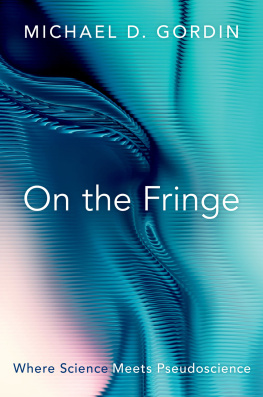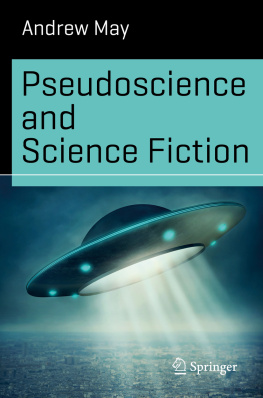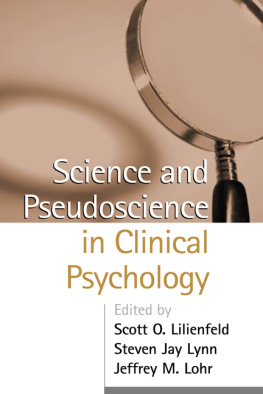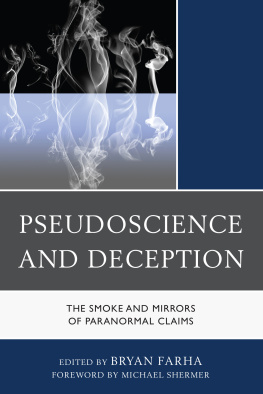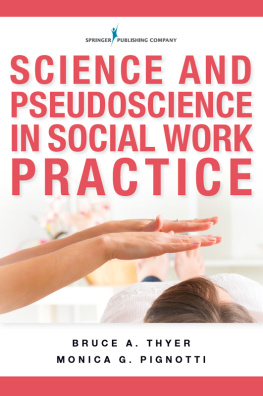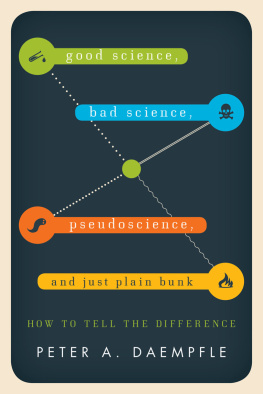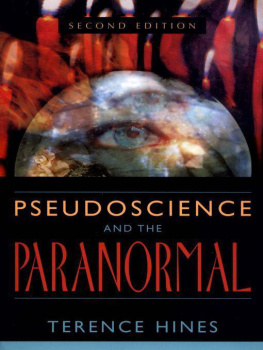Pseudoscience
The Conspiracy Against Science
Edited by Allison B. Kaufman and James C. Kaufman
The MIT Press
Cambridge, Massachusetts
London, England
2018 Massachusetts Institute of Technology
All rights reserved. No part of this book may be reproduced in any form by any electronic or mechanical means (including photocopying, recording, or information storage and retrieval) without permission in writing from the publisher.
This book was set in ITC Stone Serif by Westchester Publishing Services. Printed and bound in the United States of America.
Library of Congress Cataloging-in-Publication Data
Names: Kaufman, Allison (Allison B.) editor. | Kaufman, James C., editor.
Title: Pseudoscience : the conspiracy against science / edited by Allison Kaufman and James C. Kaufman.
Description: Cambridge, MA : The MIT Press, [2017] | Includes bibliographical references and index.
Identifiers: LCCN 2017025528 | ISBN 9780262037426 (hardcover : alk. paper)
Subjects: LCSH: Pseudoscience.
Classification: LCC Q172.5.P77 P73 2017 | DDC 001.9dc23
LC record available at https://lccn.loc.gov/2017025528
To my parents, Jean and Joe Katz, the original scientists in my life
ABK
For my parents,
Drs. Alan S. and Nadeen L. Kaufman,
Who nurtured in me a lifelong love of learning and science (and the arts) and taught me to question, wonder, and dream
JCK
Contents
- Scott O. Lilienfeld
- David K. Hecht
- Emilio J. C. Lobato and Corinne Zimmerman
- Fernando Blanco and Helena Matute
- Dean Keith Simonton
- Kevin M. Folta
- Britt Marie Hermes
- Leif Edward Ottesen Kennair, Ellen Beate Hansen Sandseter, and David Ball
- Jonathan Howard and Dorit Rubinstein Reiss
- Arnold Kozak
- Chad Orzel
- Dennis M. Gorman
- Jeffrey Beall
- Adam Marcus and Ivan Oransky
- David H. Gorski
- Steven Jay Lynn, Ashwin Gautam, Stacy Ellenberg,and Scott O. Lilienfeld
- Mark Benisz, John O. Willis, and Ron Dumont
- Christopher C. French
- Clyde Freeman Herreid
- Seth C. Kalichman
- Kavin Senapathy
- Indre Viskontas
- Paul Joseph Barnett and James C. Kaufman
- List of Figures
- The Mller-Lyer illusion.
- The same configuration of the Mller-Lyer illusion induces depth perception when further details (such as shades, windows) are added. (Figure elaborated by the authors.)
- Contingency matrix with four possible event types, with one cause and one effect.
- Contingency matrix containing trial frequencies that suggest a positive causal relationship, but yield a null contingency value (i.e., P = 0).
- Main results of the experiment reported in Blanco et al. (2014). The left panel shows the mean proportion of patients to which the participants gave the fictitious drugor, in other words, the probability with which they administered the cause, P(Cause), in each of the two groups. The right panel shows the mean effectiveness judgments given by participants in the two groups. Error bars depict 95 percent confidence intervals for the means. Blanco, F., Barberia, I., and Matute, H. (2014). The Lack of Side Effects of an Ineffective Treatment Facilitates the Development of a Belief in Its Effectiveness. Public Library of Science ONE, 9(1): e84084.
- Four simulations of the Rescorla-Wagner learning model. Using this model we simulated learning under four different contingency tables: one positive, one negative, and two involving null-contingency matrices. One of the null-contingency matrices included both cause- and outcome-density manipulations, which resulted in an overestimation of the null contingency. This would be equivalent to a causal illusion. The parameters used for these simulations are the same as those used in the simulations of the Rescorla-Wagner model reported by Vadillo, Blanco, Yarritu, and Matute (2016): CS = .30, Context = .10, Outcome = Outcome = .80.
- The disciplines of physics, chemistry, biology, psychology, and sociology placed in a Comtean hierarchy of the sciences. The horizontal axis indicates the rank and the vertical axis indicates the composite score on the definitional factor.
- The Frankenfood Paradox. Techniques of plant genetic improvement that are less invasive and more predictable, and that affect the fewest genes, are the ones that bother people most. Ranging methods with unpredictable outcomes are well accepted.
- A comparison chart of MD and ND credits in the first two years of each program, published and widely used by the naturopathic profession (Association of Accredited Naturopathic Medical Colleges, n.d.-a). The numbers are based on funny accounting, which seems to inflate naturopathic training. The graphic is adapted from a graph that originally appeared on the website of the Association of Accredited Naturopathic Medical Colleges. It is no longer available. The authors of the original graph claimed that it accurately compared the credit load for the medical degree program at the University of Washington and the naturopathic degree program at Bastyr University for the 2010 academic year.
- A chart comparing the naturopathic curricula to the medical curricula at top universities in the United States (California Naturopathic Doctors Association, 2013). The total number of training hours for naturopathic students comprises time spent learning naturopathic therapeutics, which include debunked and unproven therapies like homeopathy and chiropractic techniques. Naturopaths use this misleading figure alongside the amount of real training completed in medical schools to make it seem as though naturopaths receive equivalent training as medical doctors.
- Non-fatal injury rates for selected activities based on A&E attendances in the United Kingdom (Play Safety Forum, 2012, p. 11).
- A flier first issued in 1955 warning about dangers of the polio vaccine, which had been invented three years prior.
- James Gillrays 1802 caricature of Jenner vaccinating patients who feared it would make them sprout cowlike appendages.
- A mathematical explanation of why autism symptoms are bound to emerge after vaccination in some children.
- Causal Loops Depicting How Researchers Manipulate the Evidence-Based Review System. Use of flexible data analysis practices (top loop) and minimal adherence to study design criteria (bottom loop)
- Program Flow. A: Pre-NREPP; B: NREPP as envisioned; C: NREPP in practice.
- One of two evaluation sections of a peer review report from a questionable publisher. (Quoted from an anonymous peer review shared with the author.)
- List of Tables
- Key Findings from the Project TND Evaluations Cited in the NREPP Review of the Program
- Statistically Significant Main Effects in the Project TND Evaluations Reported in the NREPP Review
- CAM Subtypes as Defined by NCCIH after 2011
- Subtypes of CAM as Defined by OCCAM
- The Seven Principles of AIDS Denialism
- A Brief History of AIDS Denialism
Foreword:Navigating a Post-Truth World: Ten Enduring Lessons from the Study of Pseudoscience
Scott O. Lilienfeld
We find ourselves living increasingly in a post-truth world, one in which emotions and opinions count for more than well-established findings when it comes to evaluating assertions. In much of contemporary Western culture, such catchphrases as Dont confuse me with the facts, Everyone is entitled to my opinion, and Trust your gut capture a troubling reality, namely, that many citizens do notand in some cases, apparently cannotadequately distinguish what is true from what they wish to be true. This overreliance on the affect heuristic, the tendency to gauge the truth value of a proposition based on our emotional reactions to it (Slovic, Finucane, Peters, and MacGregor, 2007), frequently leads us to accept dubious assertions that warm the cockles of our hearts, and to reject well-supported assertions that rub us the wrong way. We are all prone to this error, but one hallmark of an educated person is the capacity to recognize and compensate for it, at least to some degree.
Next page

